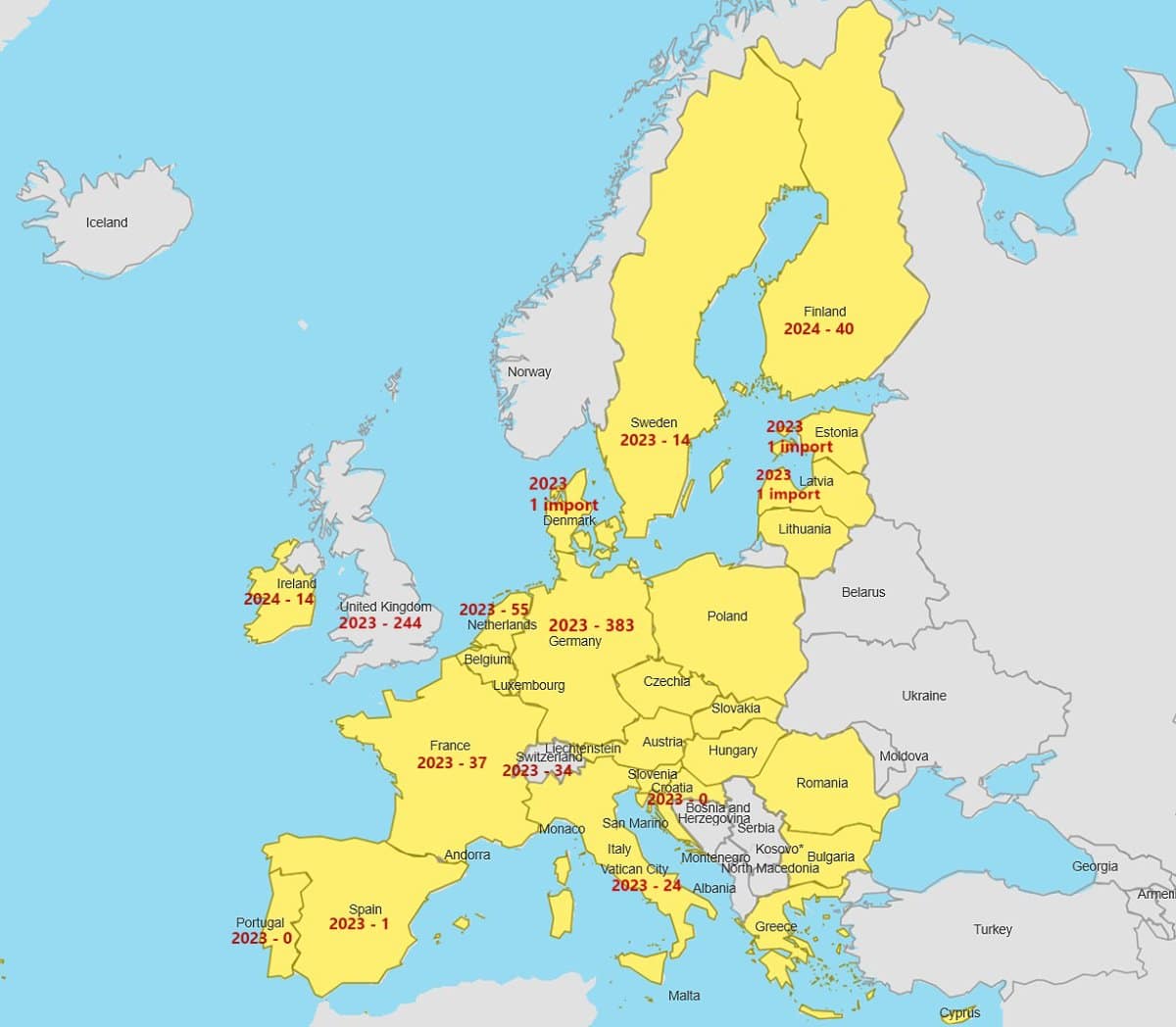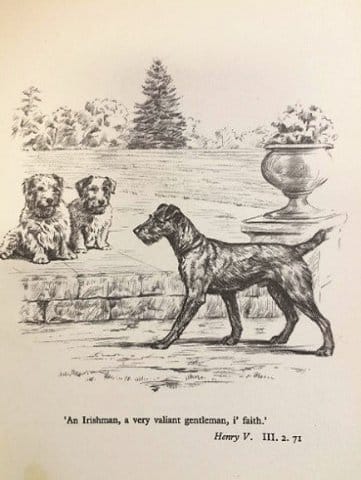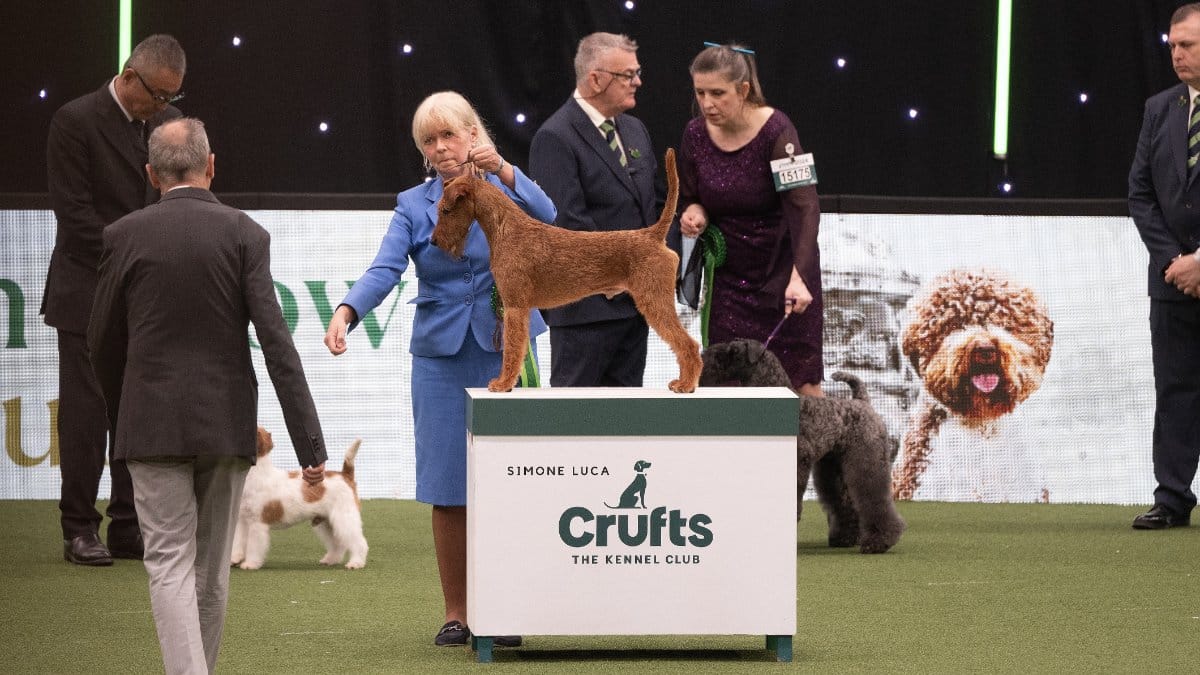


Home » The Irish Terrier: Across the Pond

Where is “Europe” on the dog world map? The European continent has 27 member countries in the European Union1, while the Fédération Cynologique Internationale (FCI) recognizes 34 full-member nations under the category “European.” Surprisingly, this list includes the Russian Federation and Israel. Let’s focus on the 26 countries on the European continent that are part of the political framework of the European Union and recognized by the FCI as European members. I will take the liberty of including a plus-one, Switzerland. Despite its absence from the European Union it is an active participant in the FCI, up to the highest levels.

Reproduction of the rare Irish Terrier in Europe is, inevitably, an international collaboration. Fortunately, Irish Terrier kennels are typically welcoming and open to engaging with their counterparts across borders. However, this collaboration does come with challenges, as the costs associated with travel and breeding can be significantly affected by the varying economic conditions of the countries involved. The price for a puppy (and a breeding) can range considerably, from approximately €800 in countries like The Czech Republic or Latvia to €2,500 or more in Sweden, Germany, and Switzerland.
In some countries, such as Switzerland, breeding cannot commence until each dog has successfully passed a national examination that assesses their temperament, as well as essential checks on health and conformation. Typically, European kennels will breed a female three to four times throughout her lifetime, starting when she reaches two or three years of age. Only the most renowned kennels regularly sell their dogs beyond the circle of neighboring countries. The highest and deepest quality in Irish Terriers can generally be found in the Scandinavian nations. Judging practices in these countries is seen by breeders as objective and grounded in established cynogostic4 criteria. This approach is effectively communicated through well-structured judges training programs, and Scandinavian judges enjoy particular esteem abroad, as well as at home.

Important titles, such as the European and World Dog Shows, are not favored venues for Irish Terrier enthusiasts, as they are not judged by specialists in the breed and are often viewed as politically influenced. Entries at the European Dog Show rarely exceed 13-16 dogs; those of the World Dog Show range from 20 to 30. Perhaps, a more accurate reflection of national quality can be found at club specialty shows, which are judged by invitation from the breed clubs themselves. The British Isles are the homeland of the Irish Terrier, offering a good point of reference. A specialty show in England can attract 40-60 or more entries, though in Ireland, 5-10 entries is the average. In Scandinavia, Finland can see 40-60 dogs at any good show or specialty title, and in Sweden, only slightly fewer. Germany and The Czech Republic boast rarely over 20 in number for a specialty, and regular shows slide down to 5-8 entries. In many other countries, achieving 3-4 dogs is considered a good turnout, with numbers of 0 or 1 more commonly the case.
Shows that anticipate a larger entry of Irish Terriers typically select judges known for their expertise in the breed or, at least, within the Terrier Group. As a result, recognition at these shows is held in higher regard. The most prestigious events for Irish Terriers in Europe include the Bundesseiger in Dortmund, Germany, the Helsinki Winner Show in Finland, and virtually any show in the UK, with National Terrier, in Birmingham, representing the pinnacle. Crufts, while grand and historic, often does not offer specialist judges, but is well attended as a networking and social opportunity. Just to complete the picture, there are some collective titles that are also prestigious. The Nordic Winner title is a collection of three BOB or BOS in Scandinavia. The Mediterranean Winner is a similar award in Italy, Spain, and France. Then there is the Interra show (all Terriers) organized by an independent group, usually held on the same weekend as a major cluster.

True Terrier specialist judges outside of the UK are indeed rare. Two judges in Germany stand out for their expertise in judging Irish Terriers, Margaret Moeller Siebert and Thorsten Himmrich. Peter Lauber from Switzerland, a breeder of Miniature Bull Terriers, has a keen interest in the entire Terrier Group. Angela Bann from Croatia has risen to prominence with her Kerry Blue Terriers and specializes in Group 3. The Czech Republic, with their solid population of this breed, has at least three respected judges of the Irish Terrier: Olga Forlicz, Lukasz Kozlarek, and Jaroslava Poulová. Cathy and Sean Delmar from Ireland have direct experience with several Terrier breeds and are recognized specialists in the Group.
Unfortunately, the choice of judges who breed Irish Terriers can be counted on one hand. In England, Susan Seabridge and Ann Bradley are the most knowledgeable breeder-judges. Bojan Matakovic from Croatia has established himself as a respected figure in the breed since 1993. In Sweden, we find Carl Gunnar Stafberg who has moved on from breeding Irish to Border Terriers, and Gertrud Hagström, one of the most esteemed European judges for several decades now, known for her exceptional breeding quality and impartiality as a judge. Both she and Hans Gruttner from Germany do not accept as many invitations to judge nowadays as formerly.
Standards for the Irish Terrier differ slightly between the country of origin, the Republic of Ireland (an FCI country), the UK, and the US. However, the general picture is much the same among these three versions and is true to the original guidelines drafted by the first (Irish and English) breed club, published in Vero Shaw’s Illustrated Book of the Dog (1881) and formalized as the Breed Standard. The Standard describes a rustic, normotype dog, prioritizing size, coat, and expression. Otherwise, it should be a well-built, efficient, and ergonomic dog with a gentlemanly temperament.
While the US has almost entirely fixed excellent toplines and ideal coat texture, they sometimes present dogs with “bumpy” heads5 and overly sloping croups, and are commonly oversize. Size is less of a problem in Europe and the UK, and the bumpy head rarer; however, toplines are a weak point, coat texture can be cottony, and some bloodlines have less fill of bone in the facial region. However, across the board, the Irish Terrier is the picture of vitality and good health, and, all said, strong in type.
To be sure, breed clubs are a major force behind quality. While the Irish Terrier Club6 in the US is a single club pursuing a challenging agenda, Europe is much more fragmented. The UK does not have one single club for each breed, but regional clubs. Europe has few clubs entirely dedicated to the Irish Terrier, which is generally presided over by a generic Terrier club in company with other rare breeds of Group 3. Breeding in Europe is, therefore, a question of individual breeders, their information, or lack thereof, their priorities, or lack thereof, and their opportunity to travel and see more of the breed or make acquaintances with colleagues. European Irish Terrier breeders are never brought together to discuss, collaborate, or enjoy presentations on their breed by respected colleagues, judges, veterinarians, or other scientific experts. Funds cannot be raised, or lobbies organized, for better judging. Fortunately, social media provides the opportunity to chat and see images of some dogs, though this is, arguably, a superficial advantage.
One quality that unites Irish Terrier breeders and owners around the world is their sincere dedication to the breed. This holds true in Europe, where many small breeders, sometimes working out of an apartment, will go to great lengths to continue breeding with the best dogs they can find, and then place their puppies in good homes. Moreover, there is a sense of respect and solidarity among the people active in this breed, which makes the ring a friendly place, as a rule. Suspicion of suboptimal ethics will create a rift within the community. The Irish Terrier is valued as a loving, loyal, noble companion, and all concerned breeders, judges, handlers, and owners involved in this small world must be at least as good as their dogs or else feel a chill of courteous formality from their peers.
A European Association for the Irish Terrier would be a worthy utopian goal, a conduit toward shared information, goals, and fellowship. However, Europe is currently distracted, and international politics affect the well-being of everyone in an immediate way. Attention is focused on sorting out the mounting heating and grocery bills, and following the newscasts with trepidation. However, for now, the ivory tower of Cynology continues to provide common space for dog lovers—though we have seen our respected colleagues in Russia formally excluded. Let us continue as long as possible to enjoy our marvelous breed and the responsibilities we incur in so doing, for it is a joy and privilege to savor.
